Introduction
Sustaining successful operations in any business is normally a universal confrontation that investors and managers experience as the business world, which is gradually experiencing an augmentation in market competition and customer focus.
Precisely, it costs a business some significant amount of resources, work force, and time to expand exponentially and more importantly, to gain global reputation upon which customers can build a permanent trust in its operations.
For several decades, the world has been witnessing a massive influx of approaches, stratagems, and policies enacted within organisations to improve their efficiency primarily to gain customer satisfaction and employee involvement that subsequently enhance corporate image.
A number of organisations in the current decades within developed nations have engaged in an incessant competition to woo customers to consider using their services or buy their goods.
Google Company is perhaps among the most renowned and praised global companies. This study seeks to examine why Google ranks among world’s best companies.
Background of Google Company
Perhaps the most outstanding achiever in the global business realm is the most renowned international search engine company known as ‘Google Company.’
The global population and researchers in specific have remained speculative of the uniqueness of this company that has left little known about itself within the public.
Google is one of the global companies that have managed to demonstrate an exceptional success within the shortest period ever (Great Place to Work Institute 2007).
Google Inc. started its operations in the year 1998, when two inventors, Larry Page and Sergey Brin, ingeniously combined efforts to develop the Google search engine.
Larry Page and Sergey Brin “first met at Stanford University in 1995, and in a span of one year, they had managed to develop a search engine Backrub that utilised links to determine the importance of individual WebPages” (Google Inc. 2013, Para.15).
With the support of financier and Sun co-founder, Andy Bechtolsheim, who offered approximately $100,000, Google Inc. officially began its operations in September 1998.
The modern Google Inc
The meeting of the two innovators was never in vain. Immediately after 1998, Google Inc. started to grow exponentially to the reckoning of global reputation when ‘Google doodle’ emerged and subsequently in 2000, AdWords came up.
Within four years, viz. on April Fools Day in 2004, the company introduced Gmail to support speedy search, large data storage, and storing of threaded messages (Google Inc. 2013).
After acquiring digital mapping company keyhole, the company got underway with Google Earth Google Maps in 2005 that currently feature in enhancing transit directions, live trafficking, and street-level imagery as Google Earth allow users to explore the moon and the ocean (Google Inc. 2013).
In 2006, the company made life easier by purchasing the online video sharing site YouTube that allows self-broadcasting, before the little green robot arrived in 2007 that has currently dominated features of several smart phones.
Finally, in June 2011, the company introduced Google+ project that has enhanced social networking globally. Currently, Google Inc. employs over 30,000 workers continentally.
Google Inc. Ranks among World’s Best Companies
Being an Internet communication and technology company that users consult on their daily searches and networking activities, it is beyond doubt that Google Inc. is the most popular company (Place to Work Institute 2007).
Despite a growing number of studies that are developing interests in determining corporate growth and performance improvement within the business world, Google Inc. has received very little attention from researchers and analysts.
Nonetheless, some significant studies that have been developing interest in determining world’s most attractive employers and organisations have seen some imperativeness of focusing on Google Inc.
From the latest global reports developed by these researchers, Google Inc. has constantly been growing to the extent of scooping topmost positions among world’s best multinational companies.
According to studies undertaken by the Great Place to Work Institute (2007), with approximately 440 companies applying for the topmost global ranking and best employers, Google Inc. has featured at the topmost, as business and engineering companies prefer to work for the company in three consecutive years in the United States. See appendix figure 1 A, B & C.
Factors making Google Inc best Employer
Sources from the most recent researches have been concluding that Google Inc. is currently ranking top within the business and engineering indexes as well as the most attractive employers among several other multinational companies within and outside the United States.
Despite research on giant organisations and greatest innovators declining in importance for some period, extensive empirical evidence is augmenting across the world about greatest organisations in terms of how firms observe satisfaction in all-round life matters.
The talent market for “business career seekers remains dominated by the professional services firms, known for being great places to launch a career, and by companies that offer a new working culture in a dynamic environment” (Araujo 2011, p.1).
While trying to comprehend the reasons behind the successfulness of Google Inc., numerous factors should feature in this matter including its operation styles, talent attraction and employee management/involvement, customer focus, corporate social responsibility, as well as strategic planning and management.
Operational styles for Google Inc.
Organisation’s operational techniques are normally innermost to the achievement of high standards and customer orientation that subsequently results to improving organisational reputation.
Google Inc. has focused on a number of operational techniques that improve their performance and within such parameters; Google Inc. has an operational culture upon which all Googlers believe that the company can achieve its stated vision, mission, and objectives (Google Inc. 2013).
The company believes that human beings differ intellectually not in divisions, races, wealth class, or even socio-cultural backgrounds and for any company to progress, it must understand that organisations realise success through recognising the efforts of all stakeholders (Google Inc 2013).
As stated from its website, “we strive to maintain the open culture often associated with start-ups, in which everyone is a hands-on contributor and feels comfortable sharing ideas and opinions” (Google Inc. 2013, Para.18).
Survey examining employees’ perception about culture revealed that about 95 per cent of them agree that Google has been in the vanguard in spearheading organisational culture.
In examining operational style in Google Inc., innovation within the operational engineers is what has been putting this company in topmost ranks within Multinational organisations (See fig. 2).
For any growing company, a mindset towards innovation is a great enabler of corporate image and through diversification of product and most specifically service delivery makes Google Inc. a great company (Spector, Norvig & Petrov 2009).
Inasmuch as competition is stiffening across the world, innovation has enabled Google Inc.’s engineers to invest in an assortment of products attracting and targeting all forms of technology consumers.
From simply Google search engine, the innovators have come up with Google map, YouTube video streaming, Google plus social media, Google software, and Gmail mailing services to smaller applications including the latest android project that has captured the interests of million consumers continentally (Google Inc 2013).
More interestingly, with highly talented workforce, Google has ventured in the educational paradigm and changed almost everything within the academic research in what they term as ‘Hybrid Research at Google’, thus making studying lively and interesting.
Talent attraction and employee management/involvement
Google Inc. is among the global companies that have acknowledged the importance of recognising employee’s involvement, satisfaction, and appreciating human capital and human labour within their culture thus facilitating in acquiring global repute (Google Inc. 2013).
In almost all its operations in all nations where it harbours offices, Google Inc has been ranking top. Drawing evidence from Googlers located in Canada, where Google Inc. still ranks top in service provision and innovation, the human resource manager (Mr. Woods) made it clear in an interview.
He noted, “Google makes it possible for employees to turn their great ideas into products used by people all over the world…the organisation believes in democracy at work as it concentrates in empowering workers and serving with a very flat hierarchical model” (Burchell 2012, p.3).
Presumably, employee management is not easy, but Google Inc. has managed to enhance democracy in decision-making, policy assimilation, and product designing with employees working on products in autonomous groups and teams that make their own decisions.
In the quest to hire and retain pinnacle talents in all its organisations, Google Inc. management a very talented workforce of about 30,000 Googlers globally with exceptional abilities in developing and managing advanced software within the dynamic and complicated trendy market (Great Place to Work Institute 2007).
The company has been in the forefront in providing employees with professional support through enhancement of skills and professionalism that has been achievable through providing workforce with training opportunities, extroverted resources, and equipment improvement designed in best technologies.
Among its ten viewpoints, Google Inc. management team anchors on conviction that ‘one can be serious without wearing suits’ in the sense that managers must trust their workforce, invest heavily in talent development and nurturing, as well as appreciating their efforts without making an allowance for egoism (Google Inc. 2013).
Having the focus to enhance employee involvement and motivation as well as considering employee empowerment factors such as encouraging teamwork, Google Inc has been the best workplace (See figure 3).
Customer focus & corporate social responsibility
While trying to focus on the successfulness of Google Inc. in the business world achievers paradigm, two things are evident, viz. the aspects of customer focus and corporate social responsibility.
Since its emergence in about a decade ago, Google Inc. has concentrated in improving its rapport with customers and the community by ensuring that customers receive the best services and the communities surrounding them receive support in their communal growth (Google Inc. 2013).
Among the organisational cultures bestowed in Google Inc., customer focus has been one of the integral secrets that put the company in the Global reputation with one of its topmost values indicating that Google Inc. focuses on customers before anything else.
From its website, Larry Page and Sergey Brin affirm, “Whether we are designing a new Internet browser or a new tweak to the look of the homepage, we take great care to ensure that they will ultimately serve you” (Google Inc 2013).
Customer focus in Google Inc. exceeds organisational ambitions.
None of the global greatest achievers has managed to succeed without prioritising on respecting and honouring the assistance provided by the surrounding societies.
Google has been ranking top in maintaining corporate social responsibility since it decided to venture in software engineering and global networking and almost all communities surrounding its offices admit that Google Inc. plays an imperative role in societal growth.
Google has been supporting “free gourmet or epicure program involving meals inclusive of breakfasts, lunches, and evening meals almost everyday to all its employees, while extending its support by bettering local rapport through assisting regional anglers and farmers” (Great Place to Work Institute 2007, Para. 16).
Google has been offering humanitarian aid including supporting Second Harvest Food Bank that saw them spend approximately $50,000, and $500 take-out meal for new parents in the organisation.
Driven by the value that an organisation can succeed without engaging in any form of evil, both employees and the communities surrounding Google Inc. are supporting its corporate growth.
Strategic planning and management
Organisational management and in essence strategic management has been key to the discussions growing within determining management factors that contribute to organisational success or failure (Jaruzelski et al. 2012).
Stratagems and policymaking within Google Inc. have been core issues that have enhanced strategic focus of the company thus making it feature among top multinational achievers.
Strategic planning always begins with how the organisation builds its hierarchical structure and from their management structure Google Inc. has a strong leadership structure stretching from executive officials, board of directors, to other significant senior leadership that oversee consistency and performance (Google Inc. 2013).
These highly qualified professionals engage collective and common goal oriented decision and policymaking processes that enable Google Inc. to feature top among other multinational corporations.
Another integral feature of strategic management is having mission, vision and other focus tools that drive organisations towards success. Google’s mission is “to organise the world’s information and make it universally accessible and useful” (Google Inc. 2013).
Conclusion
The corporate world has been speculative of the integral reason that places some organisations within the topmost achievers worldwide with secrets of companies such as Google Inc. remaining a quandary to many.
Google Inc. has featured within the world’s most attractive employers severally with the notion of employee engagement, customer focus, and corporate social responsibility being some major success secrets that put Google Inc. among top global achievers.
More interestingly, Google Inc. has remained determined in integrating customer and employee related factors in its operations, thus making it the most preferred employer within a short span of only one decade.
Bearing in mind that the technological paradigm is full of competition and challenges, Google Inc. has remained dedicated towards investing in nurturing the available talents and attracting new ones with a continuum of expansive resources available for professional growth and development.
Engaging in improving its rapport with the public through extensive involvement in corporate social responsibility has been just like fun to Googlers with matters involving communal growth prioritised.
Reference List
Araujo, J. 2011, Google is the World’s Most Attractive Employer. Web.
Burchell, M. 2012, Canada’s Best Workplaces: The results of the 2012 Great Place to Work Institute surveys are in. Web.
Google Inc.: about Google Company2013. Web.
Great Place to Work Institute: Why is Google so great? 2007. Web.
Jaruzelski, B., Loehr, J. V., Holman, R. 2012, The 2012 Global Innovation 1000 Key Findings. Web.
RepTrak: The World’s Most Reputable Companies: A Reputation study with Consumers in 15 Countries 2012. Web.
Spector, A., Norvig, P. & Petrov, S. 2009, Google’s Hybrid Approach to Research. Web.
Appendix
Figure 1: Google Inc Rank topmost preferred employee
Ranking in Top Ten
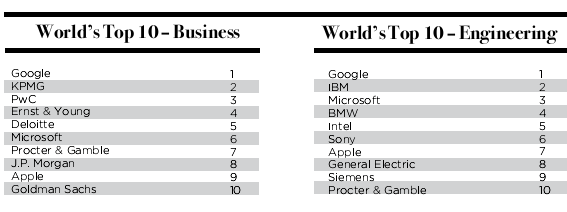
Source: Araujo
Ranking in Top Fifty (2011 report)
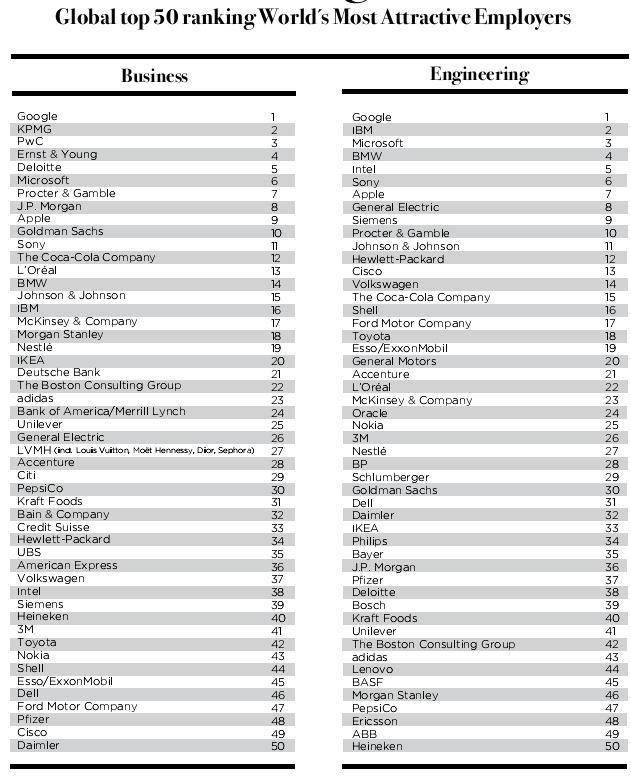
Source: Araujo
Ranking in Top 50 (2012 report)
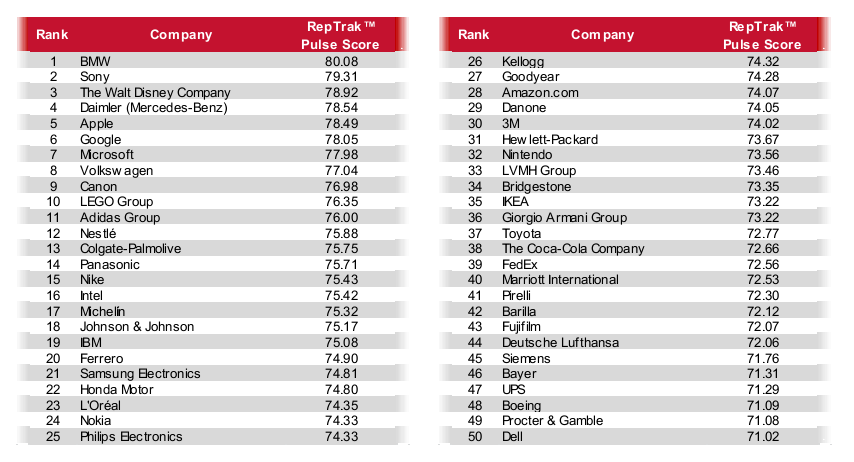
Source: RepTrak, p.10
Figure 2: Google Inc among top service providers and innovative companies
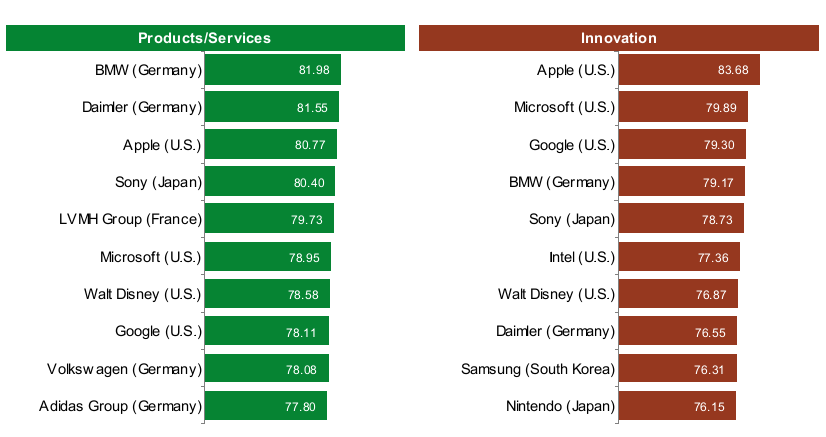
Source: RepTrak
Figure 3: Google Inc is the best workplace according to seven key dimensions
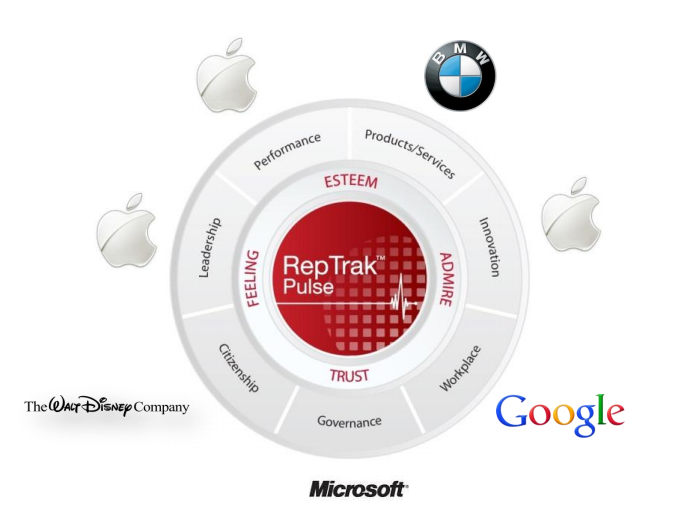
Source: RepTrak